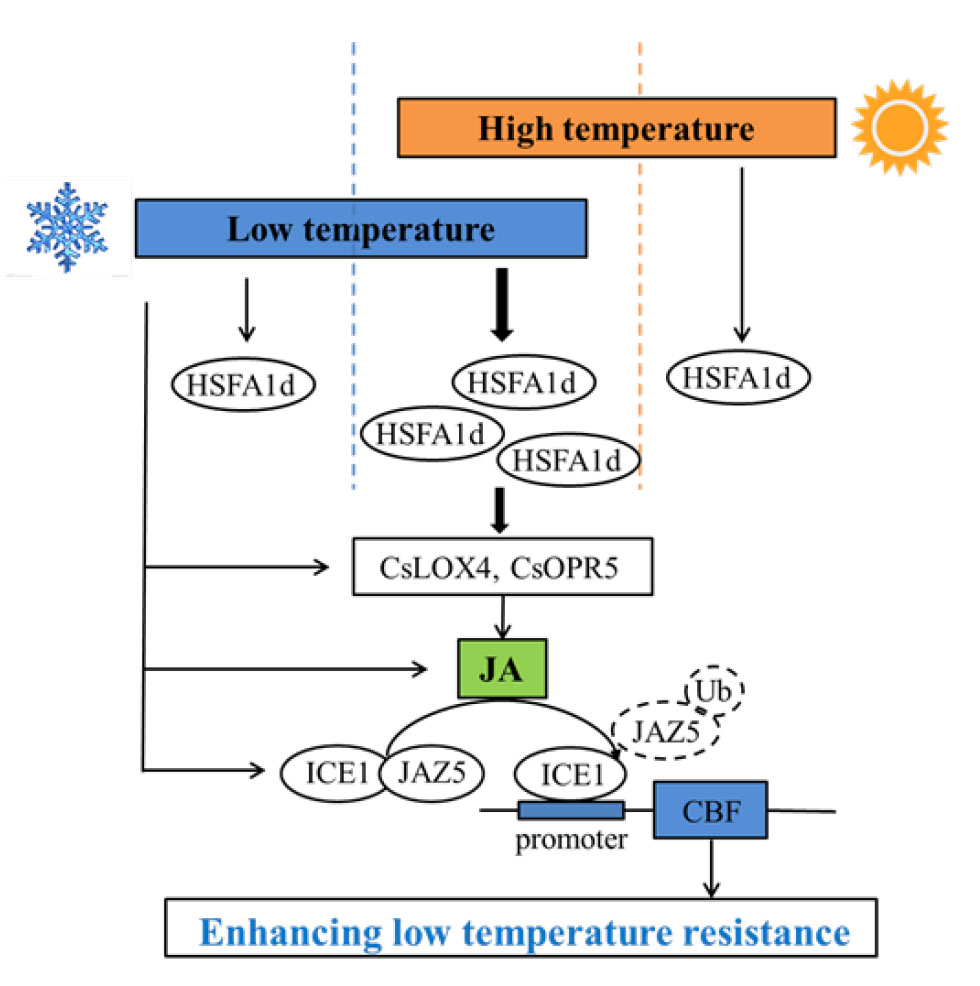博文
the plant journal:热激诱导黄瓜低温适应的分子机制
||
Heat shock induced cold acclimation in cucumber through CsHSFA1d activated JA biosynthesis and signaling
第一作者:Chuandong Qi
第一单位:中国农业大学
通讯作者:Yang-Dong Guo
Abstarct
背景回顾:Cucumber (Cucumis sativus) originated in tropical areas and is very sensitive to low temperatures. Cold acclimation is a universal strategy that improves plant resistance to cold stress.
黄瓜来自于热带地区,对于低温十分敏感。低温适应是提升植物低温抗性的通用策略。
主要研究:In this study, we report that heat shock induces cold acclimation in cucumber seedlings, via a process involving the heat shock transcription factor HSFA1d.
本文中,作者发现热激能够通过热激转录因子HSFA1d来诱导黄瓜幼苗的低温适应。
结果1-HSFA1d表达模式:CsHSFA1d expression was improved by both heat shock and cold treatment. Moreover, CsHSFA1d transcripts accumulated more under cold treatment after a heat shock pretreatment than with either heat shock or cold treatment alone.
CsHSFA1d基因的表达同时受到热激和低温的诱导。此外,在热激预处理后,CsHSFA1d基因在低温处理下会积累更多的转录本,且要比单独的低温或者热激处理更加多。
结果2-HSFA1d过表达或敲低:After exposure to cold, cucumber lines overexpressing CsHSFA1d displayed stronger tolerance for cold stress than the wild type, whereas CsHSFA1d knockdown lines by RNA interference were more sensitive to cold stress.
在低温处理后,过表达CsHSFA1d基因的黄瓜株系相比于野生型表现出更强的低温耐受能力,而通过RNAi获得的CsHSFA1d敲低株系则对低温胁迫更加敏感。
结果3-HSFA1d-JA:Furthermore, both overexpression of CsHSFA1d and heat shock pretreatment increased endogenous jasmonic acid (JA) content in cucumber seedlings after cold treatment. Exogenous application of JA rescued the cold-sensitive phenotype of CsHSFA1d knockdown lines, underscoring JA biosynthesis as key for CsHSFA1d-mediated cold tolerance.
此外,过表达CsHSFA1d和热激预处理都会增加低温胁迫后,黄瓜幼苗中内源JA含量。通过外施JA能够恢复CsHSFA1d敲低株系的低温敏感表型,表明JA生物合成对于CsHSFA1d介导的低温抗性至关重要。
结果4-HSFA1d-JA-JAZ-ICE1:Higher JA content is likely to lead to the degradation of CsJAZ5, a repressor protein of the JA pathway. We also established that CsJAZ5 interacts with CsICE1. JA-induced degradation of CsJAZ5 would be expected to release CsICE1, which would then activate the ICE-CBF-COR pathway. After cold treatment, the relative expression levels of ICE-CBF-COR signal pathway genes such as CsICE1, CsCBF1, CsCBF2, and CsCOR1 in CsHSFA1d overexpression lines were significantly higher than those in wild type and knockdown lines.
更高的JA含量可能导致了CsJAZ5蛋白的降解,而后者是JA通路的一个抑制蛋白。作者发现CsJAZ5蛋白能够与CsICE1互作。JA诱导的CsJAZ5降解应该能够释放出CsICE1,从而激活ICE-CBF-COR途径。低温处理后,ICE-CBF-COR途径中基因如CsICE1、CsCBF1、CsCBF2和CsCOR1等在CsHSFA1d过表达株系中的表达要显著高于野生型和CsHSFA1d敲低株系。
结论:Taken together, our results help reveal the mechanism underlying heat-shock-induced cold acclimation in cucumber.
综上,本文的研究结果揭示了黄瓜中一个热激诱导的低温适应的潜在机制。

doi: https://doi.org/10.1111/tpj.15780
Journal: the plant journal
First Published: April 18, 2022
https://blog.sciencenet.cn/blog-3158122-1334867.html
上一篇:Nature Plants:苏铁基因组
下一篇:The Plant Cell:RGL1-ARF7-IAA9介导杨树形成层发育过程中生长素和赤霉素信号转导的交联
全部作者的其他最新博文
- • Plant Physiology:CsMADS3促进柑果中的叶绿素降解和类胡萝卜素合成(华中农业大学)
- • Molecular Plant:LBD11-ROS反馈调节作用于拟南芥的维管形成层增殖和次生生长(浦项科技大学)
- • Science Advances:根结线虫通过调控植物的CLE3-CLV1模块,促进侵染进程(日本熊本大学)
- • Nature Communications:油菜素内酯参与植物营养生长期转变的分子机制解析(浙江农林大学)
- • Current Biology:光合作用产生的蔗糖驱动侧根“生物钟”(德国弗莱堡大学)
- • PNAS:花同源异型基因在叶中被抑制、花中被激活的分子机制(南卡罗来纳大学)